Aston Villa struggled a lot in the previous Premier League campaign, nearly getting relegated. However, things have been completely different this season, where, after 20 games, they are closer to a top four spot than the relegation zone.
The team has improved by a lot, both offensively and defensively. According to Instat, their offensive statistics have improved as listed in this table:
| Metrics (per 90) | 2019/20 |
2020/21 |
|
Goals scored |
1.53 |
1.72 |
|
Chances |
5.1 |
7 |
|
Shots (on target) |
12 (4.5) |
14 (5.9) |
| xG | 1.27 |
1.86 |
How strong have Aston Villa been in attack this season? In this tactical analysis, we will show you their offensive organization in every phase of possession, and display how Dean Smith has transformed their attack. This season, they have more tactics and ways to score than only relying on the magic of Jack Grealish.
Build-up and verticality
Villa are not a team that insist on playing out from the back all the time. However, since the centre-backs, goalkeeper and the defensive midfielder(s) are all comfortable on the ball, their ball circulation in the first phase is usually quite good.
The build-up usually starts in a 3-1 shape, regardless of the number of midfielders, and with Douglas Luiz providing a passing option to the centre-backs by dropping deep. The goalkeeper, Emiliano Martínez, is also a part of the build-up – when he takes up a central position, the centre-backs can go wide to play as wide centre-backs. We can see this structure in the next image –
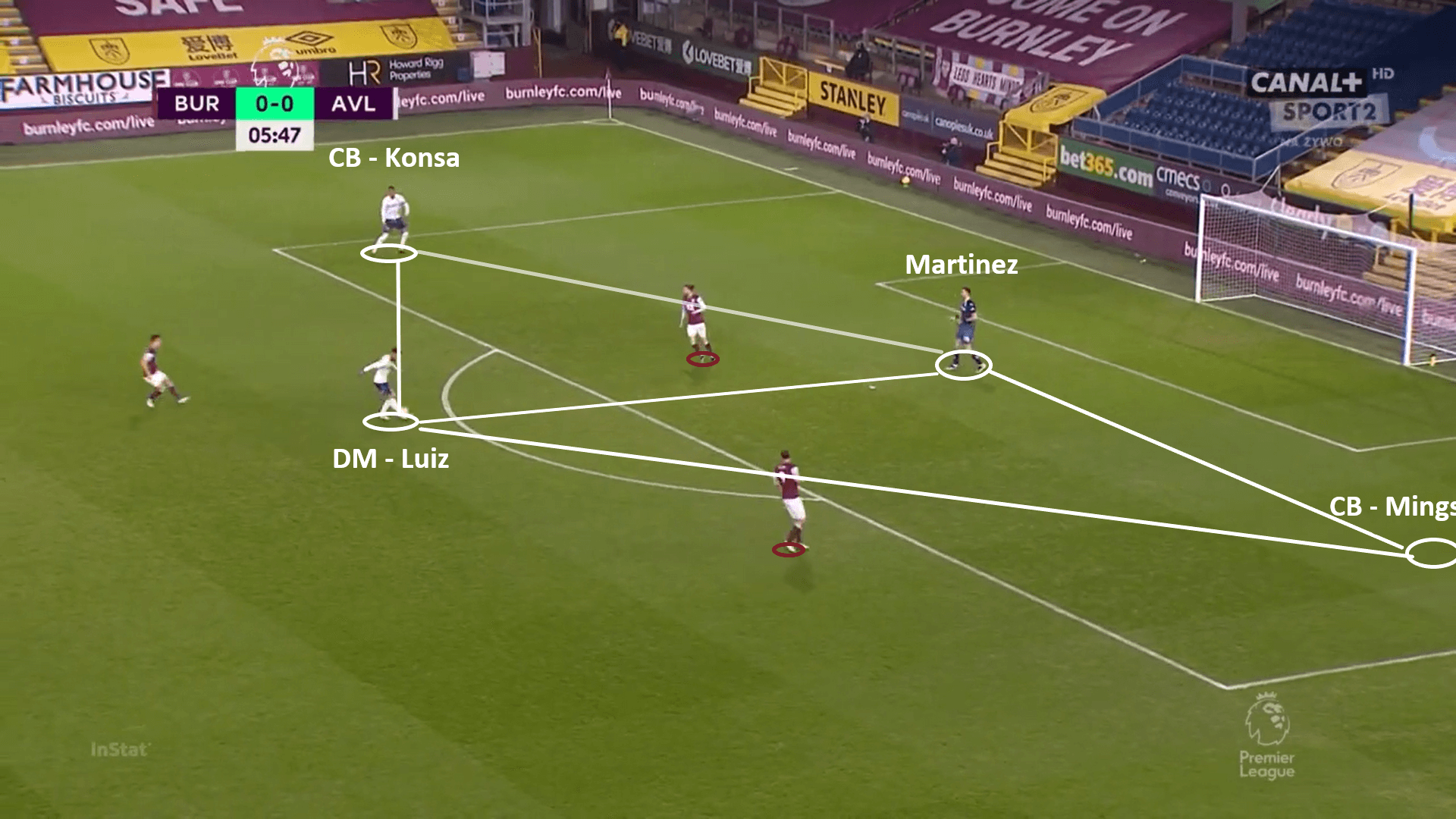
The benefit of this wide formation is to stretch the defence, especially in creating a free player against the first layer of the opposition’s 4-4-2. In this example, the strikers spread wider to try marking the centre-backs, leaving the central passing channel from Martínez to Luiz open. As this structure forms numerous passing triangles, Luiz can then find either wide centre-back as the free option to advance the ball. The spacing and positioning is good enough to avoid instant pressure from the opposition’s press.
Luiz, playing in the holding role, needs to avoid closed body positions to allow him to receive and turn without risking a costly loss of possession. In addition, he also needs to be good at playing several types of passes, including wall passes and one-twos, to absorb and release pressure when needed. All of these characteristics have made Luiz the best option in the deep midfield spot for Villa, with Marvelous Nakamba having big shoes to fill when he does play in the XI.
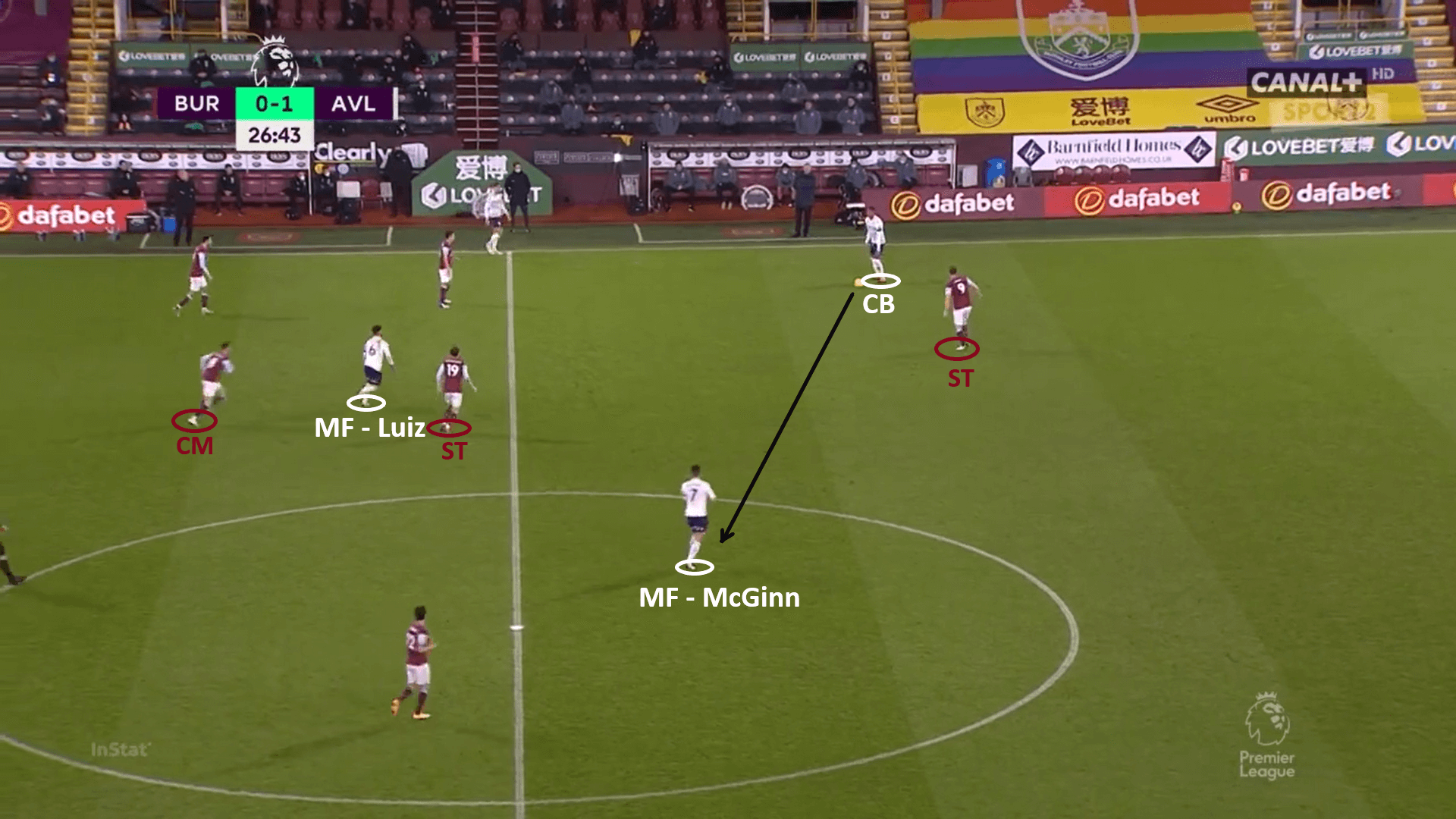
If the only holding midfielder is being marked tightly and unable to receive a pass, his partner has to drop into the first phase to provide the passing option. Usually, John McGinn has been helping Luiz in this phase. The Scottish international is extremely press resistant, able to use his body to manouevre away from opponents and run with the ball into space.
For example, in the image above, Luiz moved forward to bring away one of the Burnley strikers, and the other one is pressing the centre-back. At that moment, the holding role was gone and needed a new player in the centre, and McGinn obliged by dropping in. By this co-ordinated movement of the two midfielders, Aston Villa were able to free up a player to attack in the second phase of play.
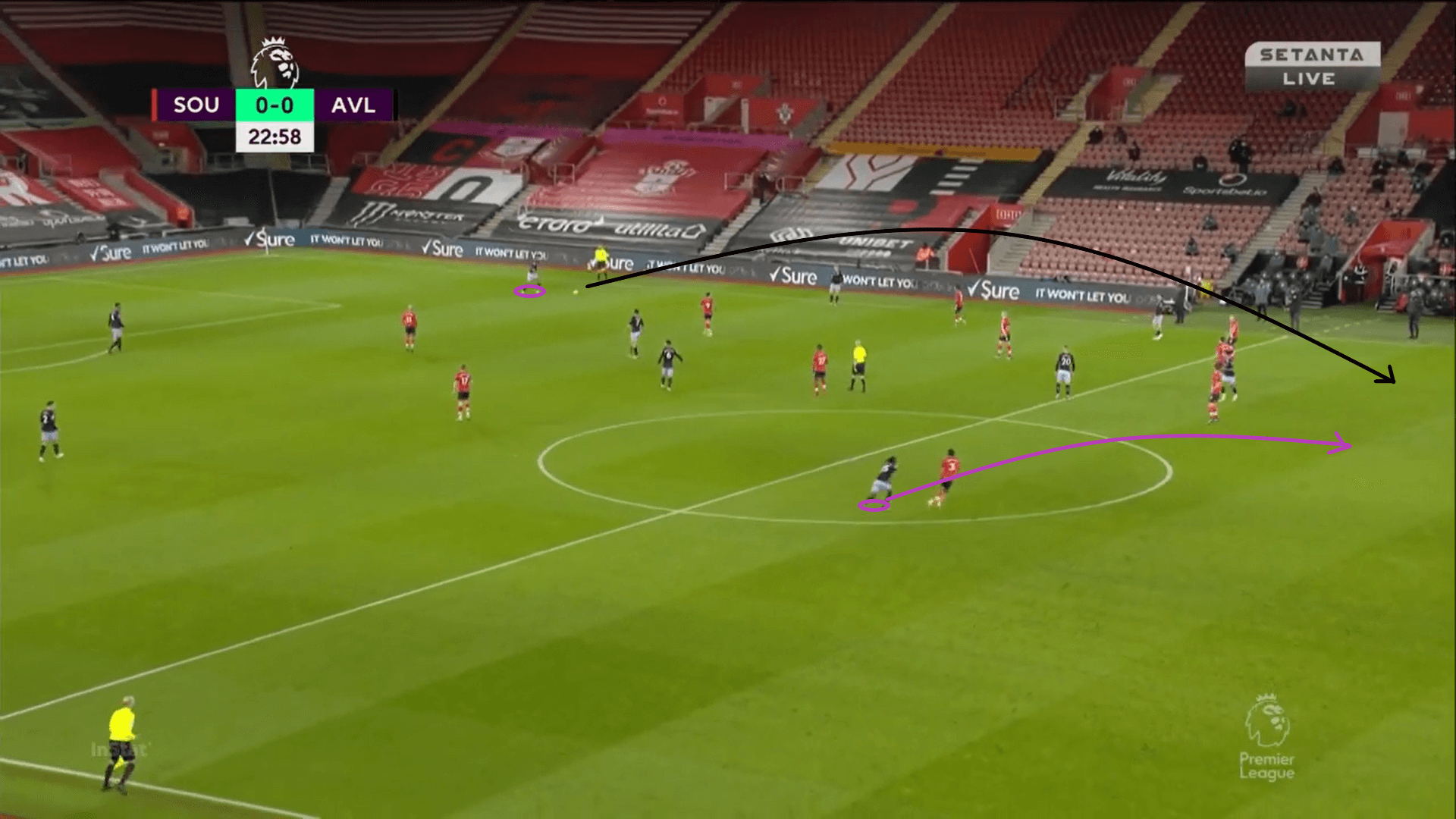
Villa’s build-up tactics have been varied this season, depending on the opposition and their strengths and weaknesses. Playing out from the back through the midfielders is one way in which they have done so. Against sides that press well but leave space in behind, or are perhaps weak in defending aerial balls, Villa have gone more direct.
Both first-choice centre-backs, Tyrone Mings and Ezri Konsa deserve more credit for their verticality in the build-up phase. Not only can they carry the ball forward at their feet, but they are also able to play passes vertically into space or to find specific targets, usually the striker.
The image above shows the habit of Villa’s front players to attack spaces behind the opposition’s defensive line, with Bertrand Traoré being particularly good at this movement. He is always quick to go behind the backline, thus keeping the opposition mentally engaged. Another point to note is that vertical passes from the back is the quickest way to advance the ball – Villa have often reached the final third with just one or two quick and direct passes. This is also an effective tool, as stated earlier, to bypass pressure from opponents.
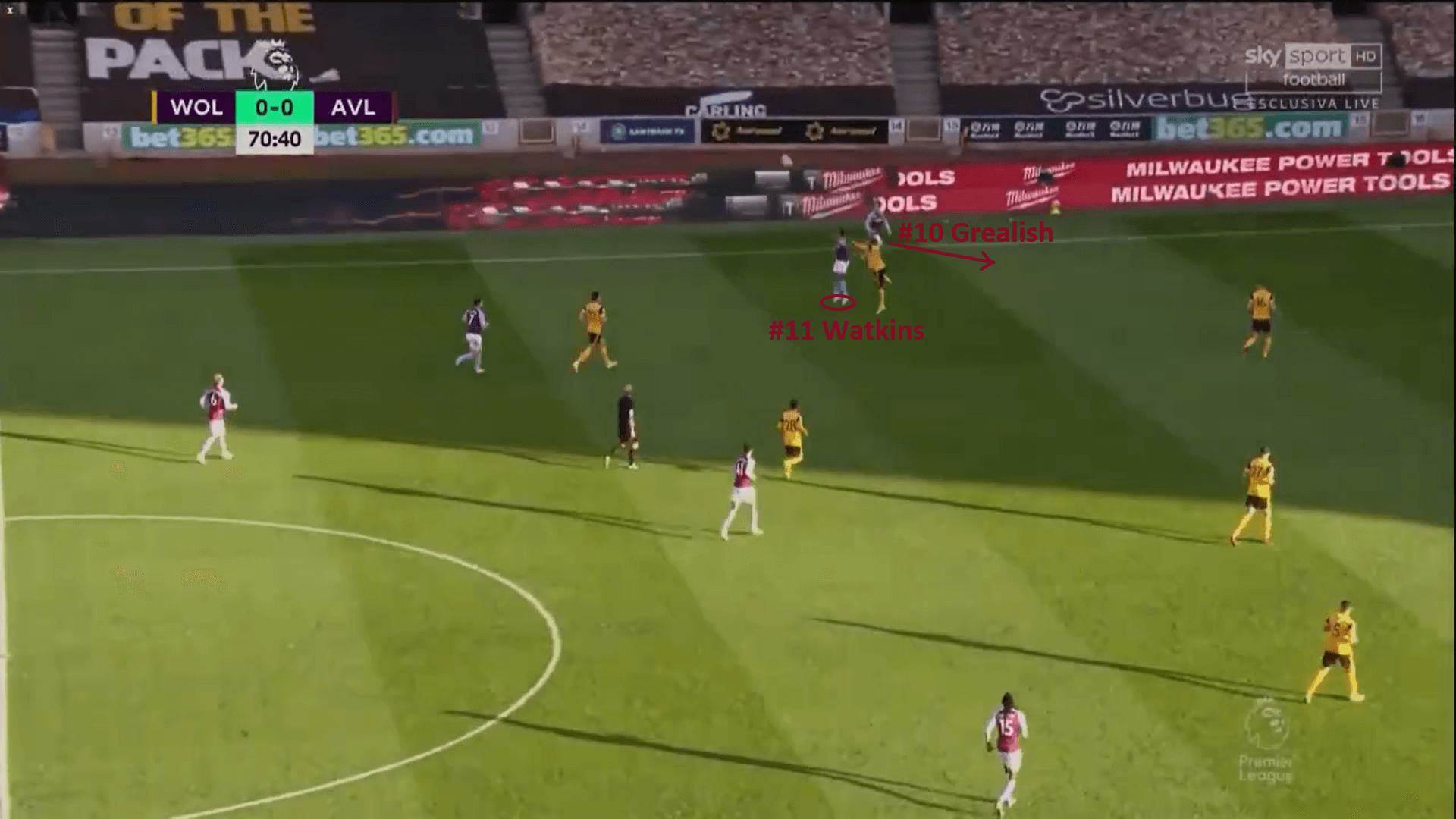
The last image in this section shows Ollie Watkins’ role when Villa play long. Despite not being muscular or tall (1.80m according to Transfermarkt), the summer signing from Brentford is good at winning duels in the air, always looking to attack the ball. This attitude and underrated aerial ability (38.9% success rate for aerial duels this season, which is better than Olivier Giroud and Michail Antonio) has often allowed Villa to win the first ball when they have played a direct pass into the final third.
Villa’s midfielders and wingers also provide support to Watkins in such situations, allowing them to win second balls frequently as well. This then has the added advantage of allowing the Clarets to attack the box with three or four players rapidly. As we can see in the image above, Watkins’ flick-on is received by Grealish, who is then able to surge into space.
Second phase
Villa’s first phase in possession has largely been simple, as they have tried to avoid the risk of a turnover of possession in their own third. There is a lot more dynamism during the second phase, which is when we see Villa’s ability to attack through different methods.
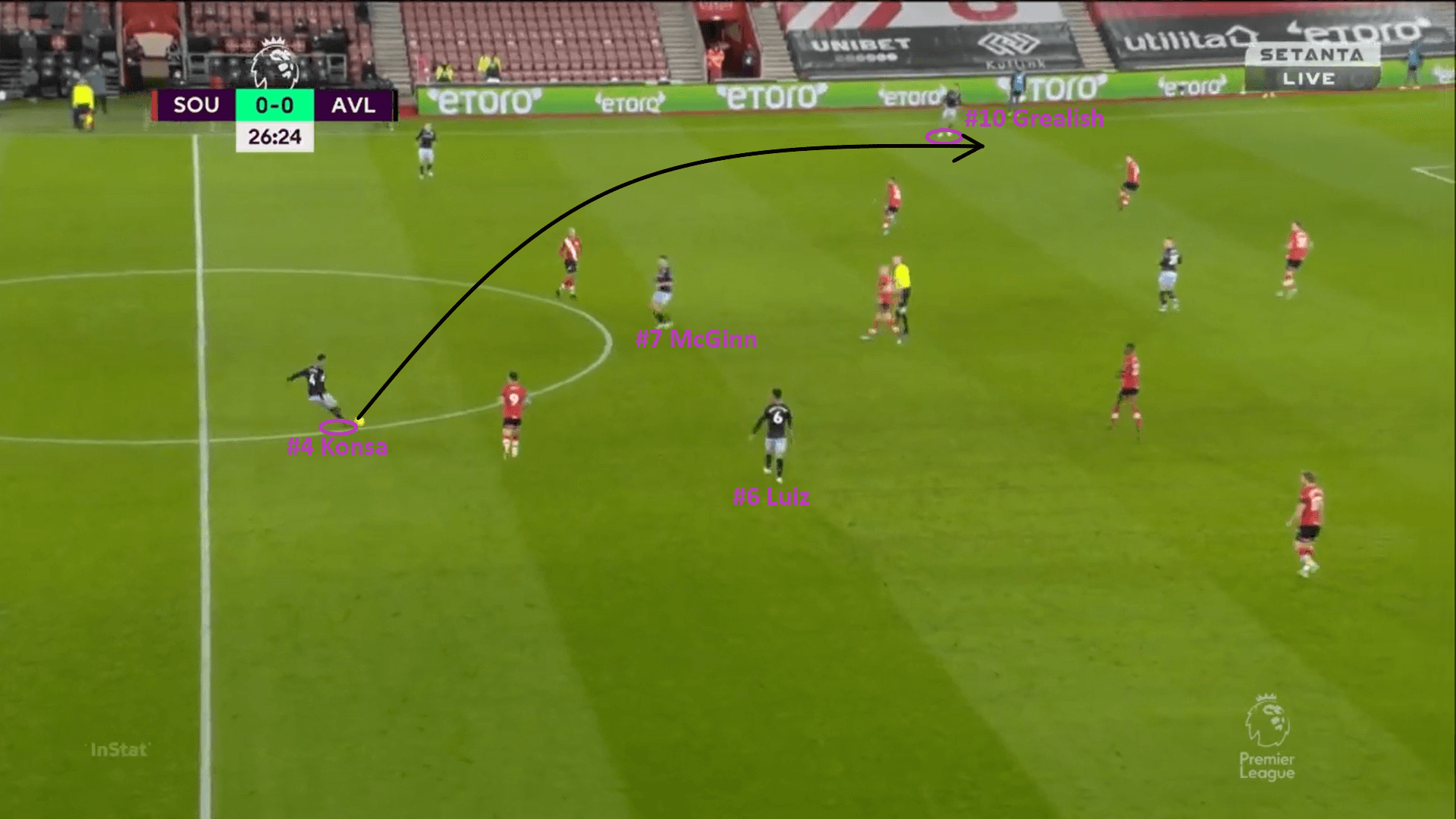
The centre-backs are good at passing, with Konsa having the ability to switch the ball to the flanks through long and accurate diagonal passes. Usually, the Villa midfielders stay higher than the centre-backs, manipulating the height of the first line. This creates the space for the defenders to play long passes without pressure.
In the above image, McGinn and Luiz stayed higher to let Konsa play the long pass. The interesting point here is the positioning of Grealish – he is more a left-winger instead of playing in the centre. This has been a smart move from Smith to keep his best player away from the opposition. Grealish has had more time and space out wide than he would have got centrally, and there have also been a few offensive patterns put in place to maximize his flair.
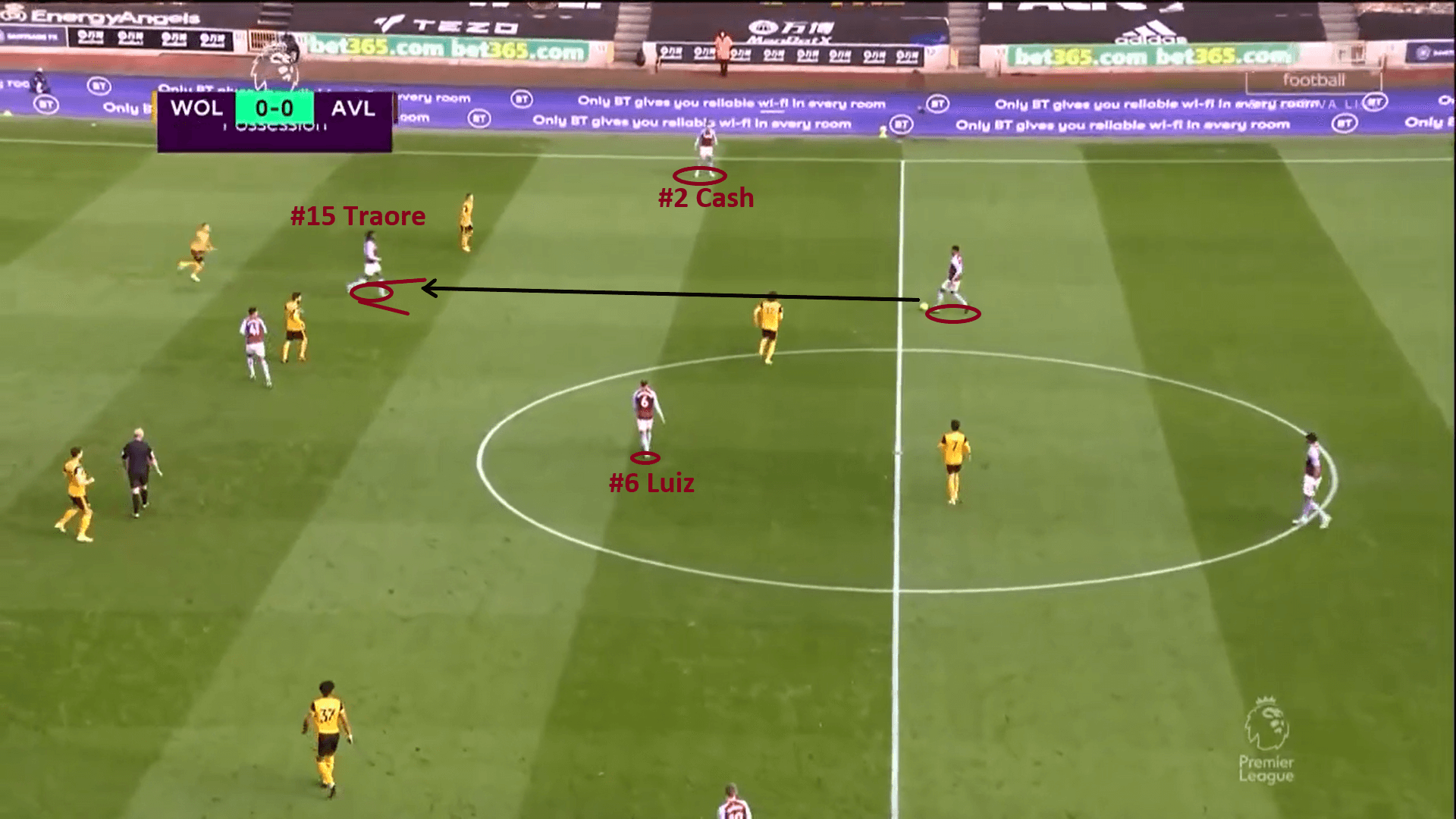
Villa’s attacking positioning has also been asymmetrical, with one winger staying high and wide to provide that option for the diagonal switch from the back, with the other dropping into the half-spaces to offer a vertical option to the centre-backs. This allowed the player on the ball in the deeper areas to have multiple options to progress the ball.
When Traoré plays, he has been the man to provide the vertical option, with Grealish going higher and wider, closer to Watkins and to the penalty box. Villa have tried to synchronize this movement with a third-man, such as Luiz above (Cash is another one). Traoré, in general, has been quick enough to make first-time decisions, avoiding excessive touches that could lead to a possession turnover.
However, the impact of this tactic has been weaker when Traoré is not playing on the right, since Grealish is then the vertical option, and further from goal as a result.
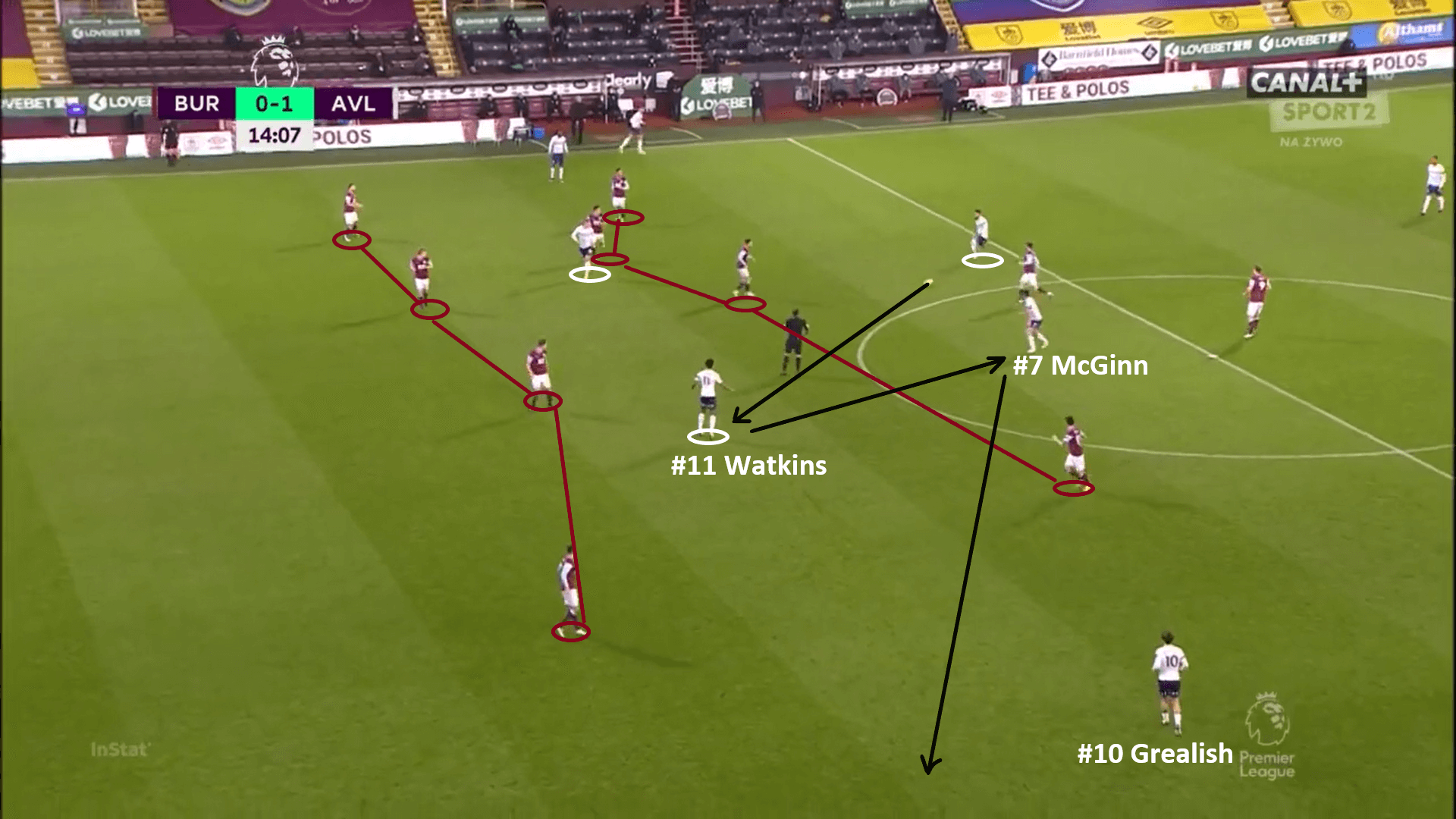
Villa have played vertically through the centre, always using third-man plays to find wide spaces and attack quickly. Another important element of their offensive organization has been to place a free player behind the opposition midfield. This player could be the inverted winger (Grealish), Watkins, the offensive midfielder (Ross Barkley) or even McGinn making a run forward.
The above example includes all these elements. Watkins and Barkley are between the lines, with the former being found by the pass from Luiz. Closing his body, Watkins quickly laid the ball off to McGinn – the third-man, who had the best vision and the widest passing angle.
Villa’s pattern has been to start the attack inside, and if the central spaces are too tight to exploit, they look for a wide pass to attack from out wide.
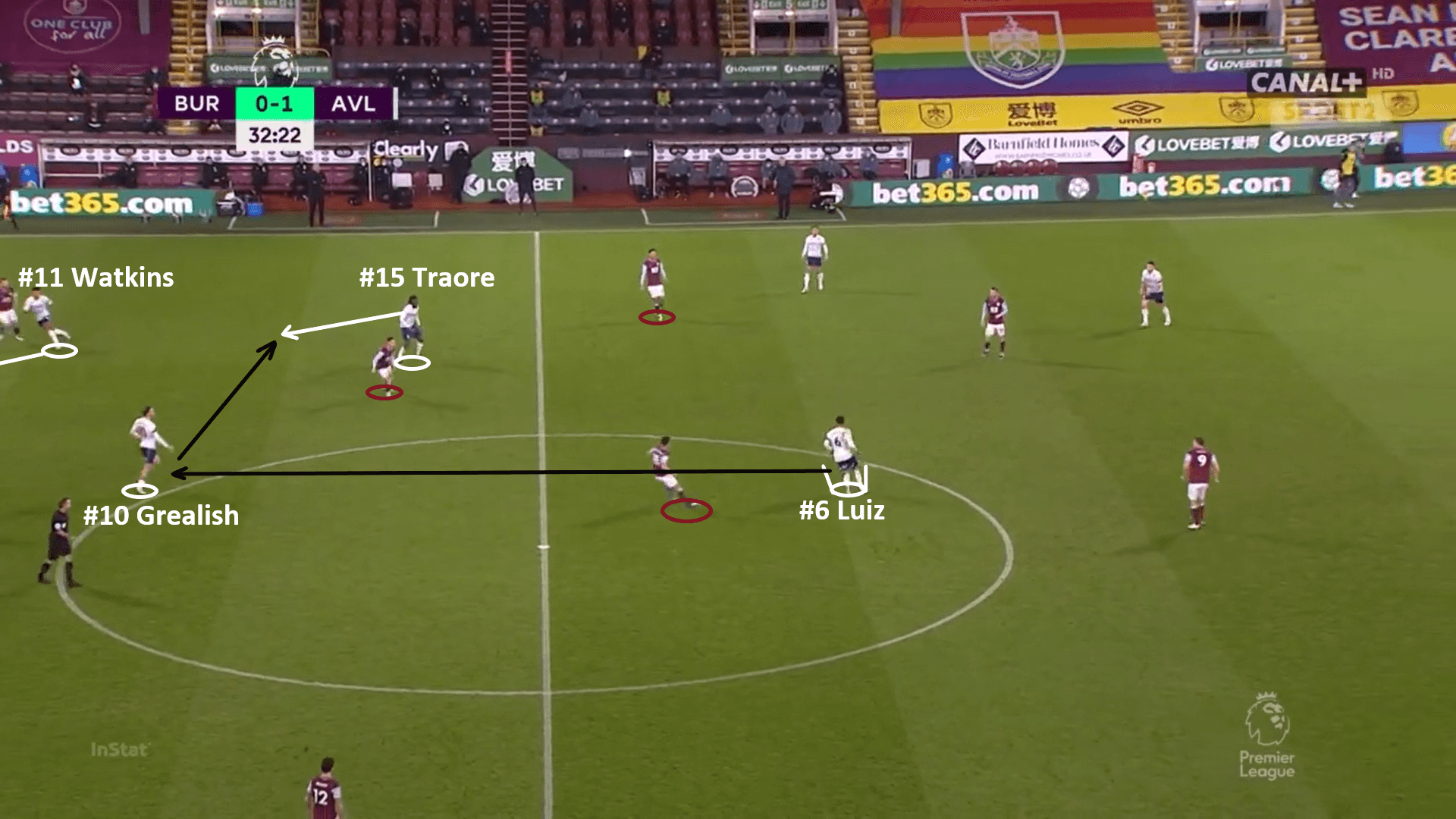
In addition, Villa’s midfielders are good enough at passing to give Villa a huge dynamic advantage in the second phase. Luiz, who mostly spends his time staying back to defend against transitions, is adept at being the deep-lying playmaker as well.
Along with verticality in his passing, he is also able to use body feints to get away from opponents. This technique allowed the player to hide his intentions and keep opponents guessing. You would think, from Luiz’s body orientation that he was looking for a pass to the right-back, but the intended receiver was Grealish between the lines.
Then, a third-man play followed which allowed them to move into the third phase very quickly.
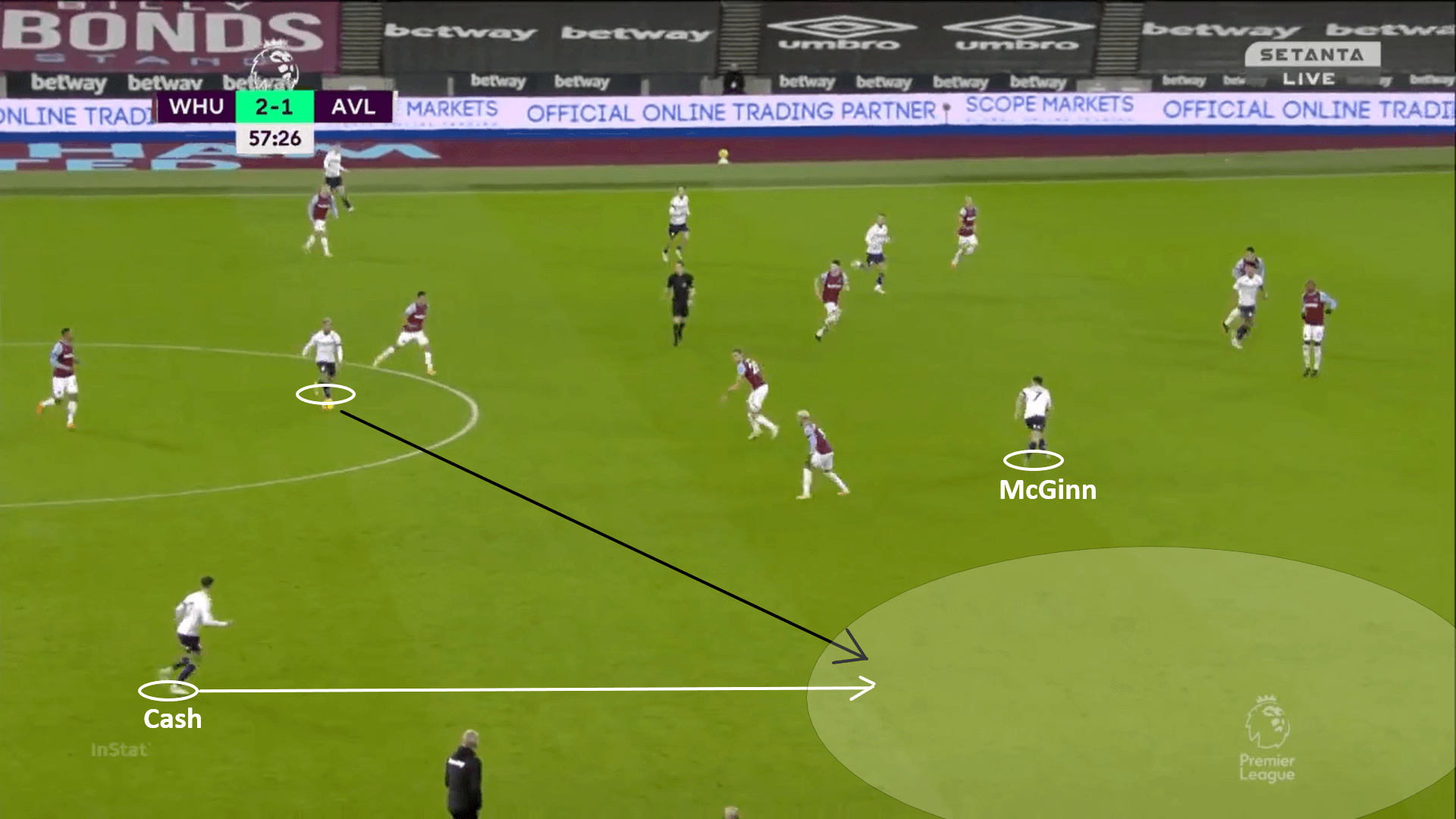
Villa also have a pair of full-backs who are good at running up and down the pitch. With these two arriving in the final third at speed, their dynamism has been strong, as we will see.
By staying deeper and joining the first phase initially, they usually began their runs down the flanks in the second phase. The likes of Luiz and McGinn are competent at finding these outlets to exploit the wide spaces left by opponents.
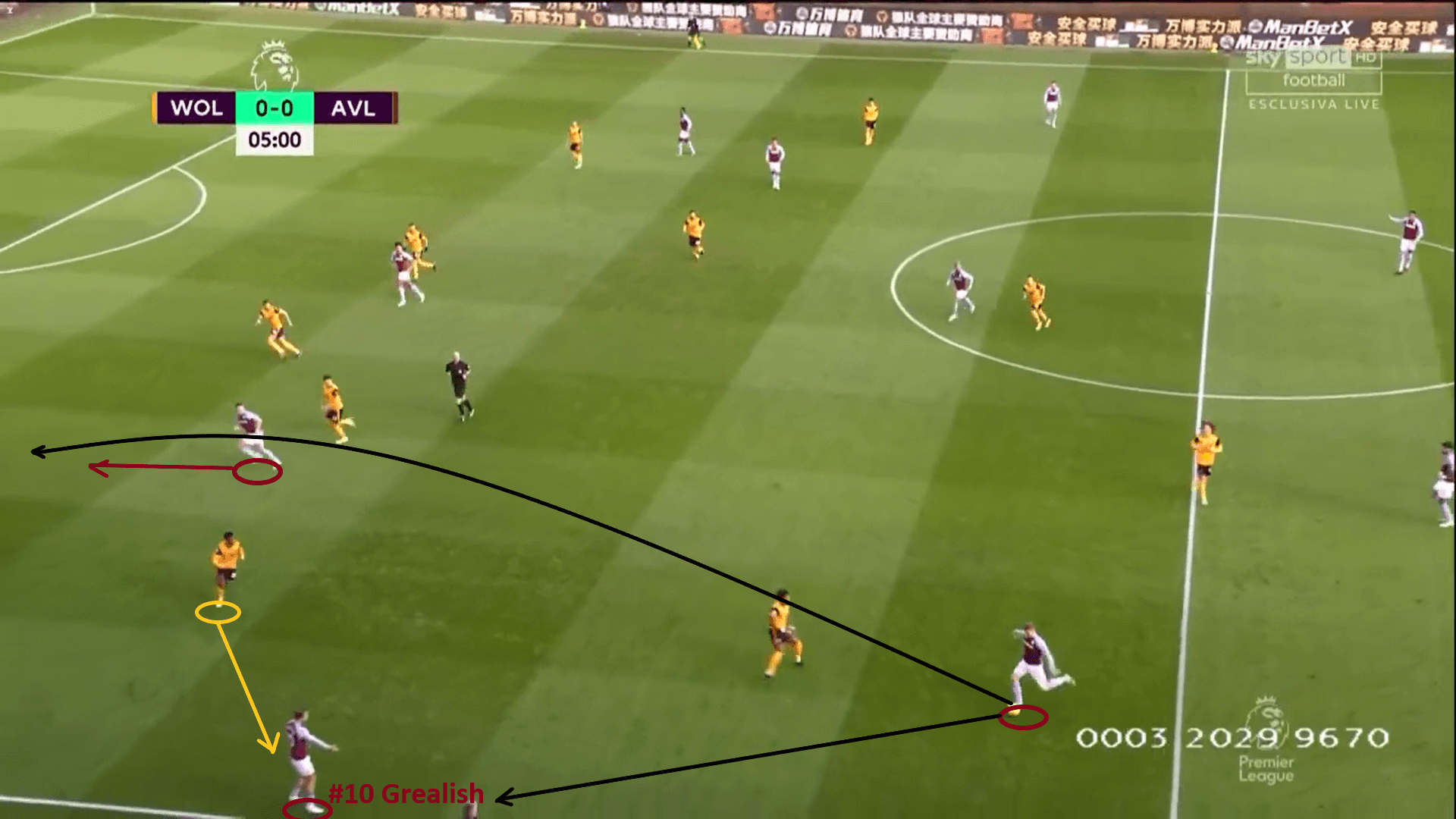
Smith’s troops are very quick at attacking out wide, and playing Grealish as the left-winger increases the dynamism of the attack. The concept to support the ball is to always provide at least a long option (the player who searches for the offensive depth) and a short option.
When Grealish drops deep, he creates a decisional dilemma for the opposition right-back, who has to choose to follow him or not. If not, Grealish has the space to receive and turn. If he does follow, space is left behind and the likes of Watkins, Barkley and Matt Targett can exploit this by running in from the half-spaces.
Villa have used this tactic against teams where the right-back comes out early to engage.
Final third dynamism
With Grealish, Villa’s dynamism in the final third was already very strong. To further improve the team’s attacking potential, Smith has put some good structures and patterns in place.
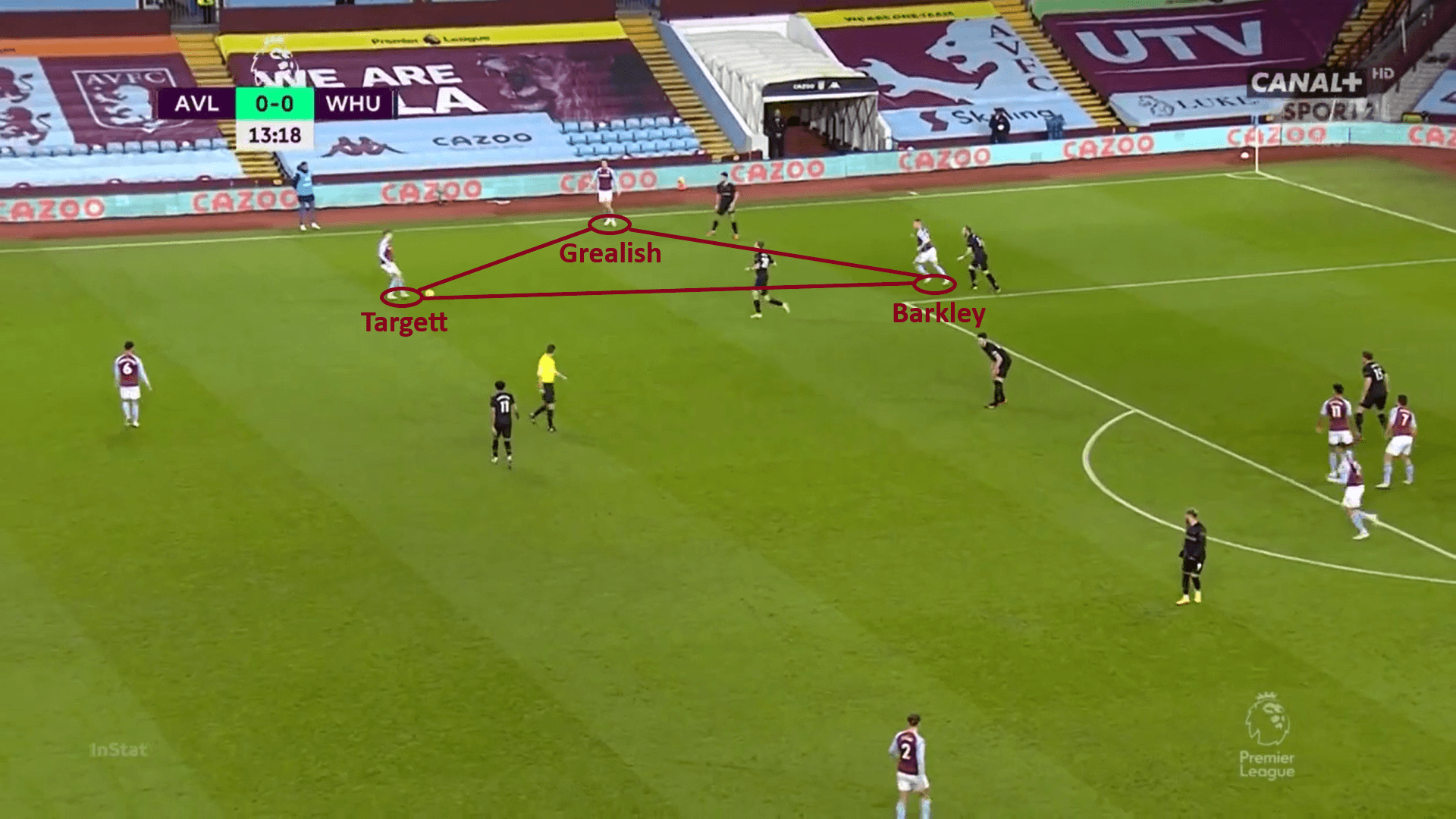
Wide triangles are a concept commonly seen in Villa’s game, formed by the ball-side winger, full-back and another player (either the striker or offensive midfielder). The concept is simple – the player out wide should always have two options to pass to keep possession and allow for ball progression.
The above image indicates this wide triangle, formed in this instance by Barkley (AM), Grealish (LW) and Targett (LB). From their positioning, we can tell that rotation is a tool to create dynamic movement in the final third.
Along with having two options to pass, if Grealish is on the ball, he can definitely dribble past the defender in 1v1 or even 1v2 situations. This makes it difficult for opponents to anticipate, and therefore, defend Villa’s attacks from out wide in the final third, especially if Grealish is involved.
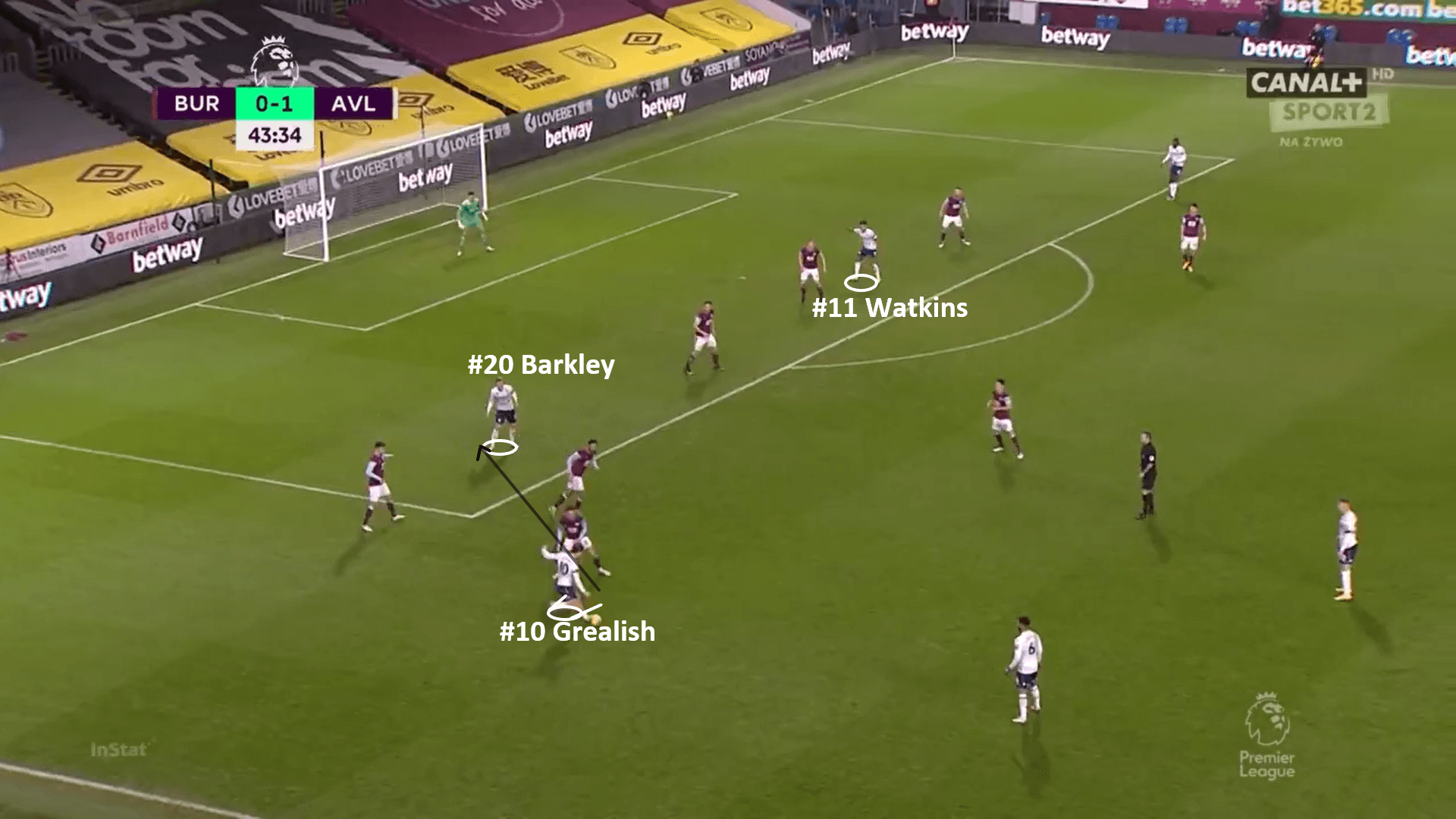
Another important part of their tactics is to support the player on the ball by running into the half-spaces from deep. No matter whether it is the winger, full-back, or midfielder making this run, this movement has been essential to create space and give the player on the ball more passing options.
In addition, Grealish’s ability to spot and execute difficult passes has also been utilized by a great extent by Villa in the final third.
For example, in the above image, the defender believes that he has blocked the diagonal passing lane to Barkley, with the passing angle being extremely narrow, making it almost impossible to play forward. However, Grealish was able to play the ball through the Burnley players legs to find Barkley in a dangerous position in the box.
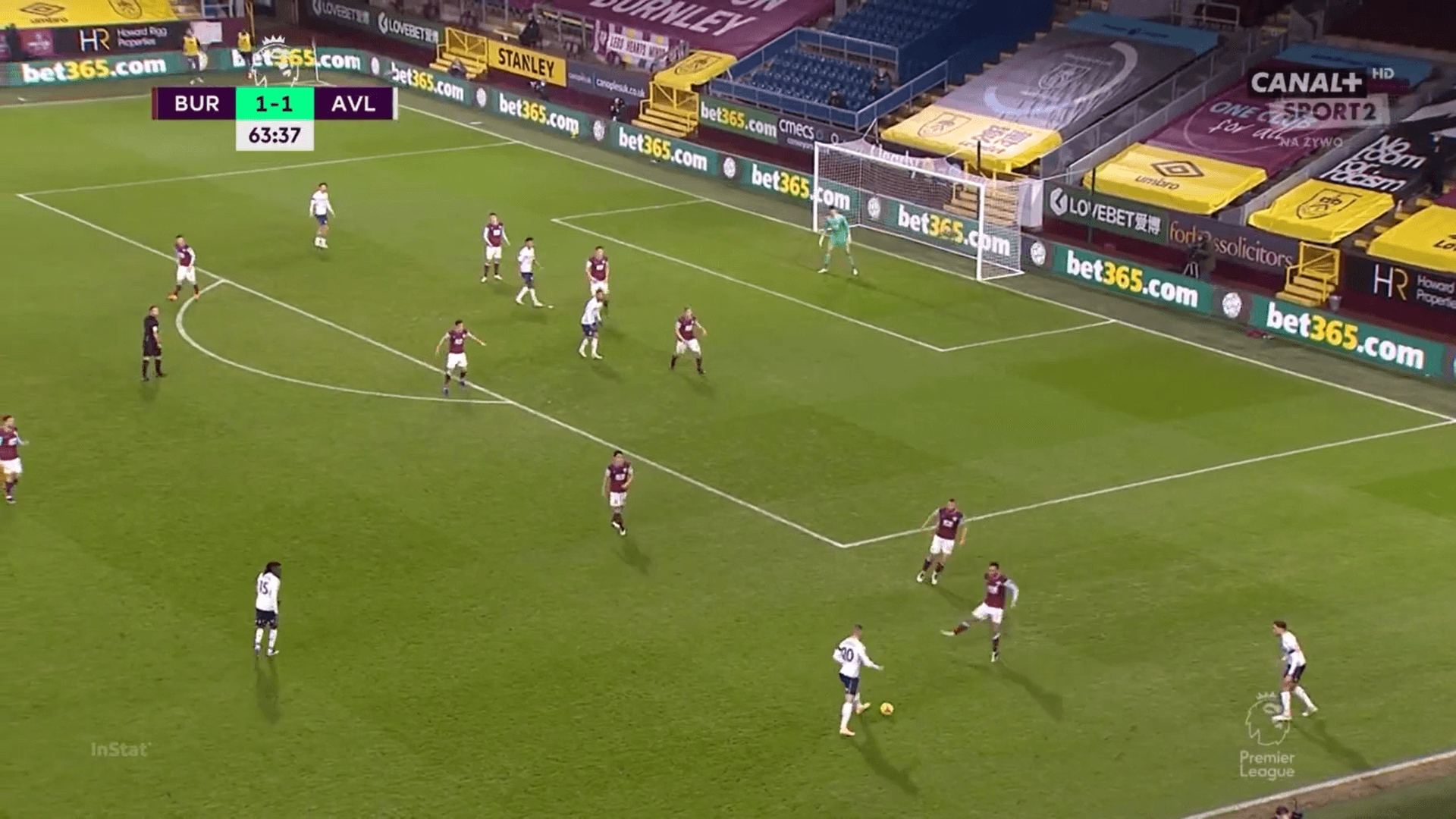
Another area where Villa have looked to maximize their strengths and mitigate their weaknesses this season is with the ability of their attackers in the air. In Wesley’s continued absence, Villa do not have any physically dominant players in their forward line. Even though we have mentioned earlier that Watkins does extremely well in the air given his size, he is not a target man by any means. Therefore, in situations like the one above, where he is static and up against physical centre-backs, he is extremely unlikely to win any aerial battles.
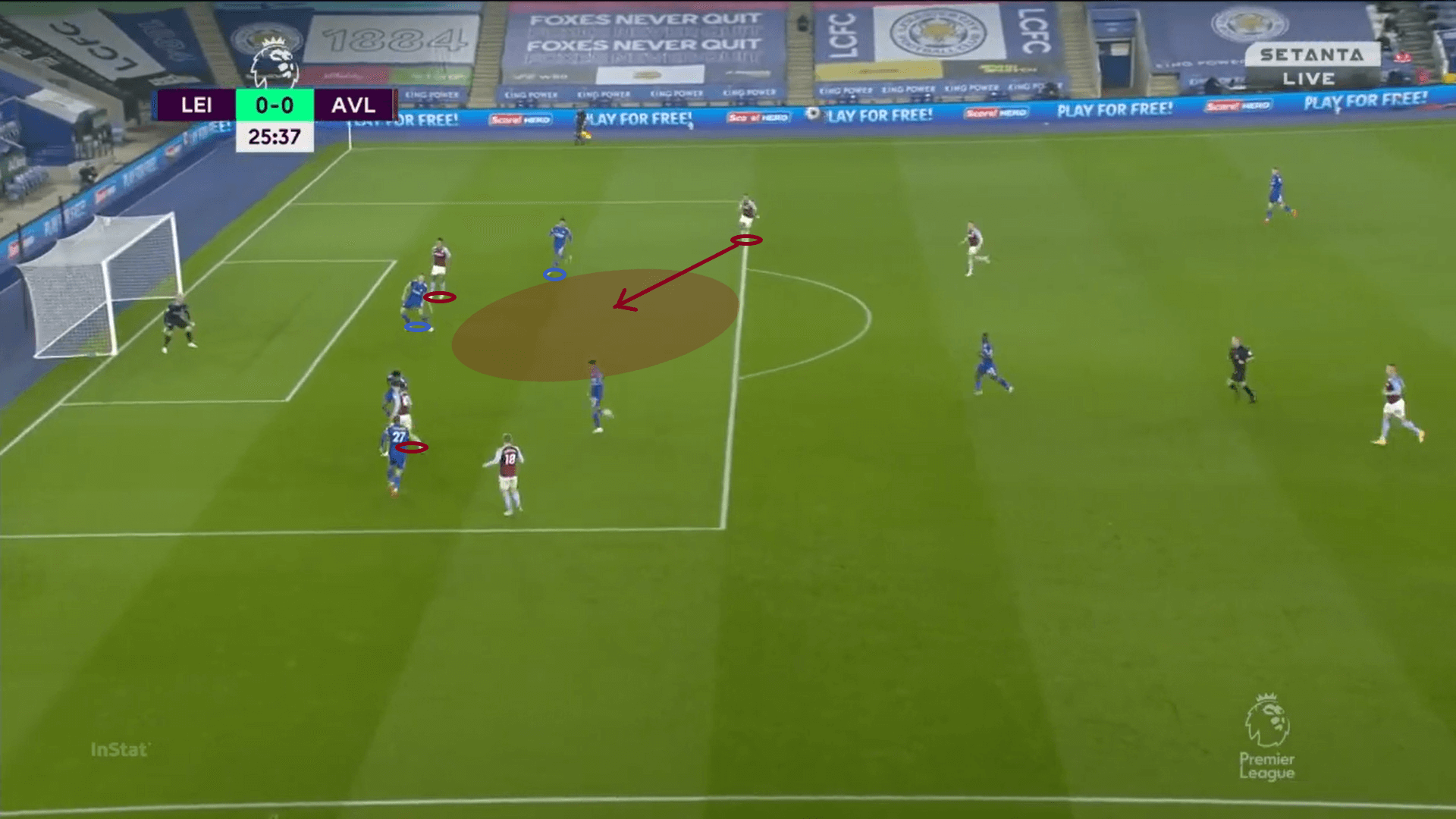
However, as we have explained in this scout report, when Villa have attacked quickly, their crossing is much more dangerous because of the dynamism generated through their movement. Villa have been excellent at having players time their runs in a staggered manner, as well as make those runs from different directions. This forces the opposition’s defensive line to adjust, and thus creates space for the player making a late run.
The image above shows how the two early runners forced the centre-backs to drop deep to cover spaces around the six-yard box. Thus, the spaces initially unavailable near the penalty spot were opened up for the late runner to attack. Since the runner came from the far-side, he also had the advantage of attacking from the defenders’ blind side.
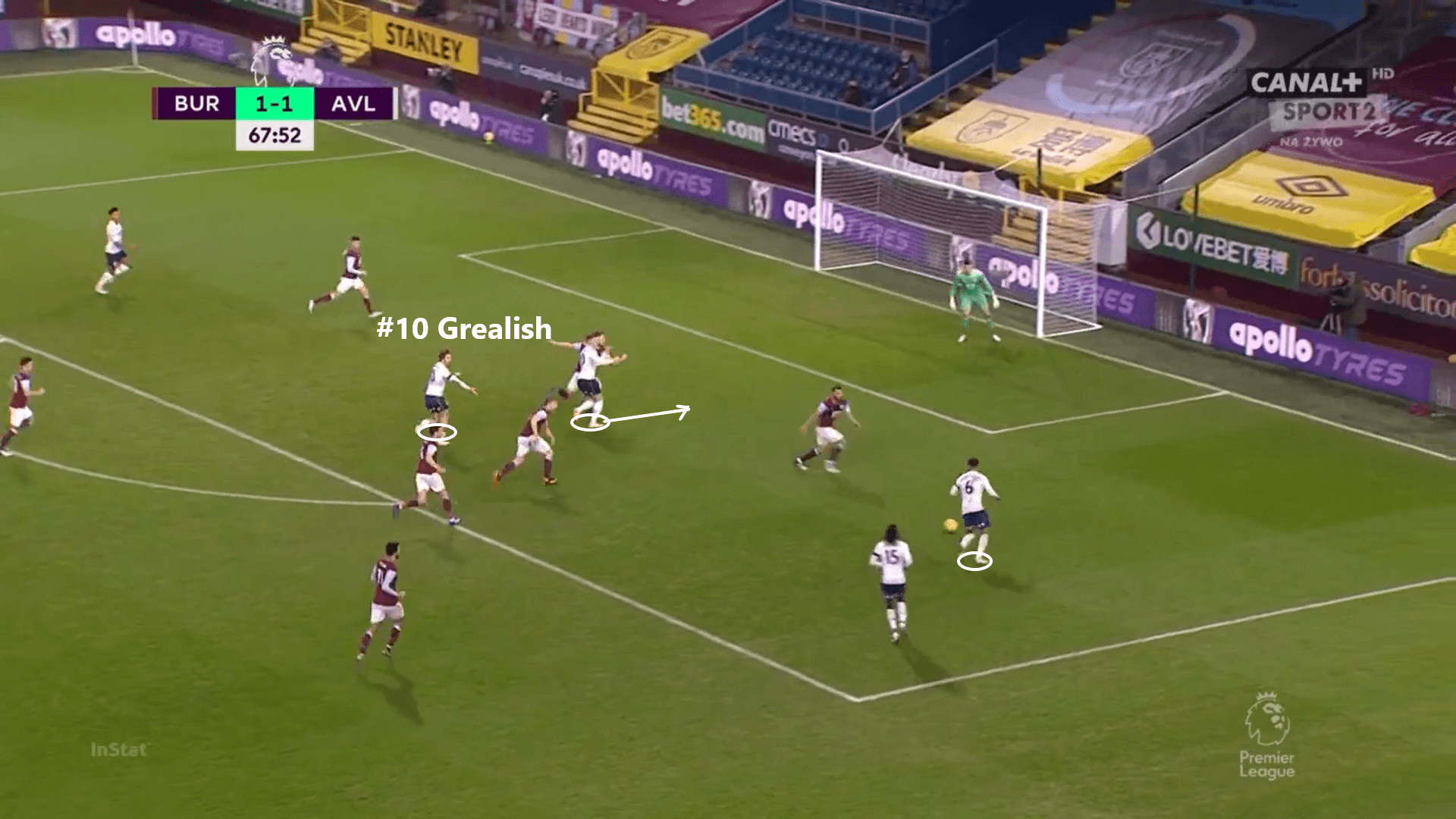
Their goals against Southampton and Burnley were a result of this tactic. The same concept was used – two differently-timed runs made from different directions to attack the box, which forced defenders to make decisions and opened space up for late runners.
Here, the first runner went forward early to attack six-yard box, opening the crossing channel to Grealish, who scored from near the penalty spot.
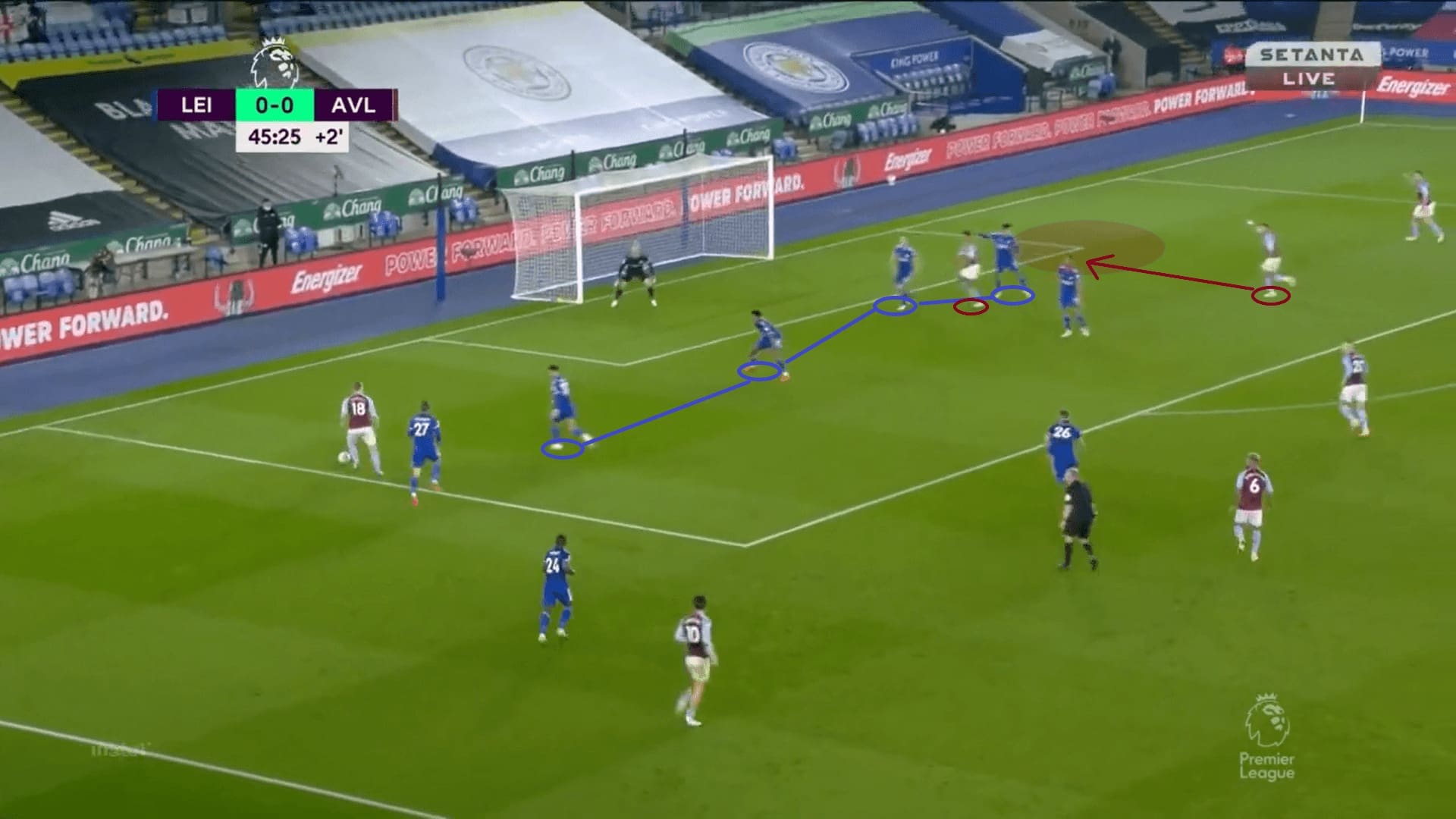
This last example shows Villa’s way of attacking spaces. Watkins is a proactive player who always aggressively attacks the ball and the six-yard box. This draws opponents towards him, which in turn can create space for teammates.
By going in front of the left-back diagonally, the back-post space was opened for the late runner to attack.
Final remarks
As we have shown in this analysis, Villa are much better offensively this season. Apart from Grealish, the likes of Watkins and McGinn have stepped up and are responsible for the dynamism seen from Villa this season. Additionally, Barkley has picked up his form quickly after arriving from Chelsea on loan. They have managed to put together a strong, quick and dynamic attacking setup, for which credit must go to Dean Smith and his coaching staff.
Even though Villa do not use complex positional play concepts, as seen from the likes of Manchester City, for example, their attacks are rapid, especially when they progress to the final third. Their mentality has been another factor which has helped them stay in games against teams at a similar level as well as those perceived to be better than them, and this has allowed them to pick up points from such encounters. Their position in the table is no fluke, and with two games in hand, Villa are in with a real shout for making a European spot this season.

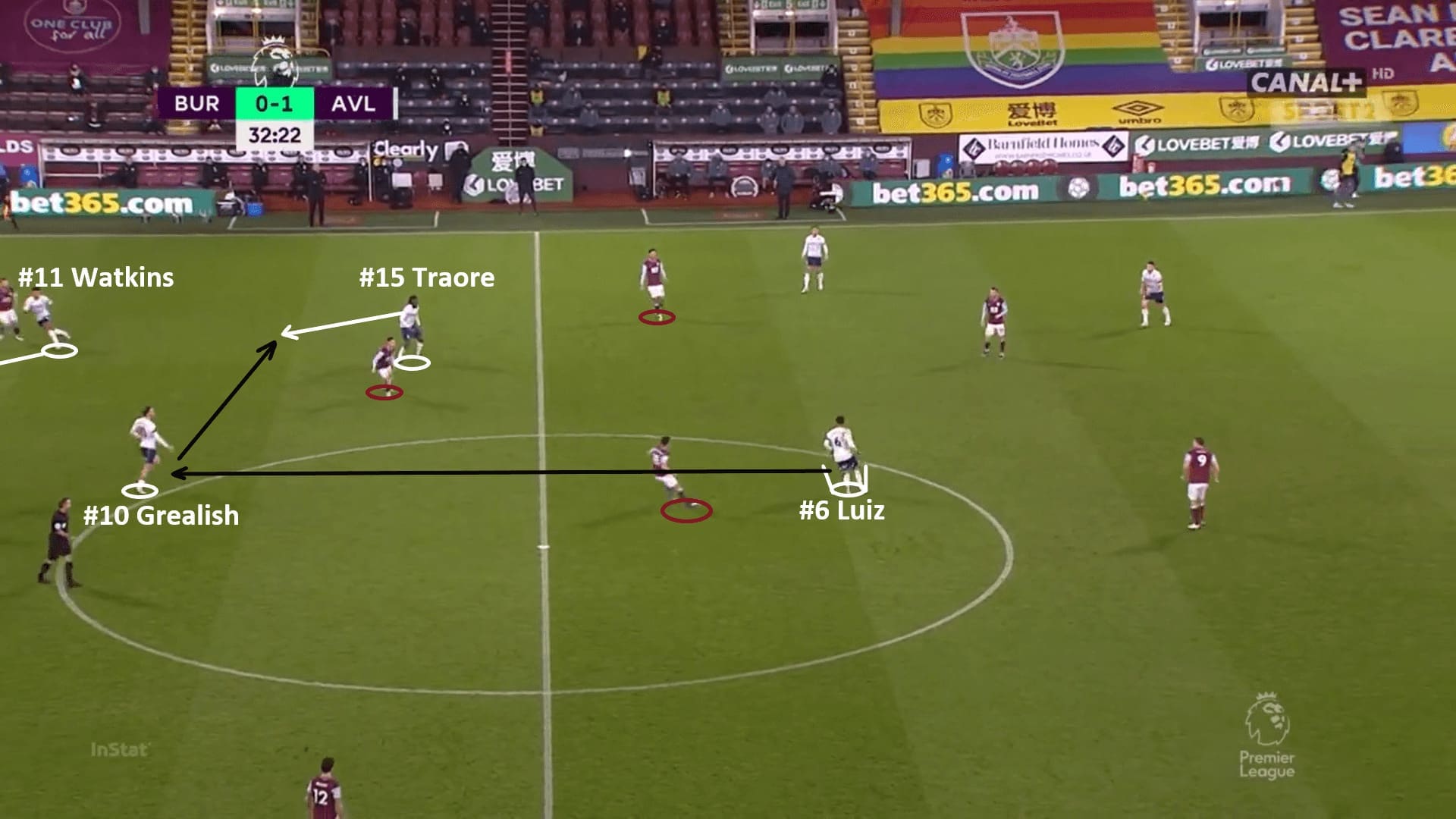



Comments